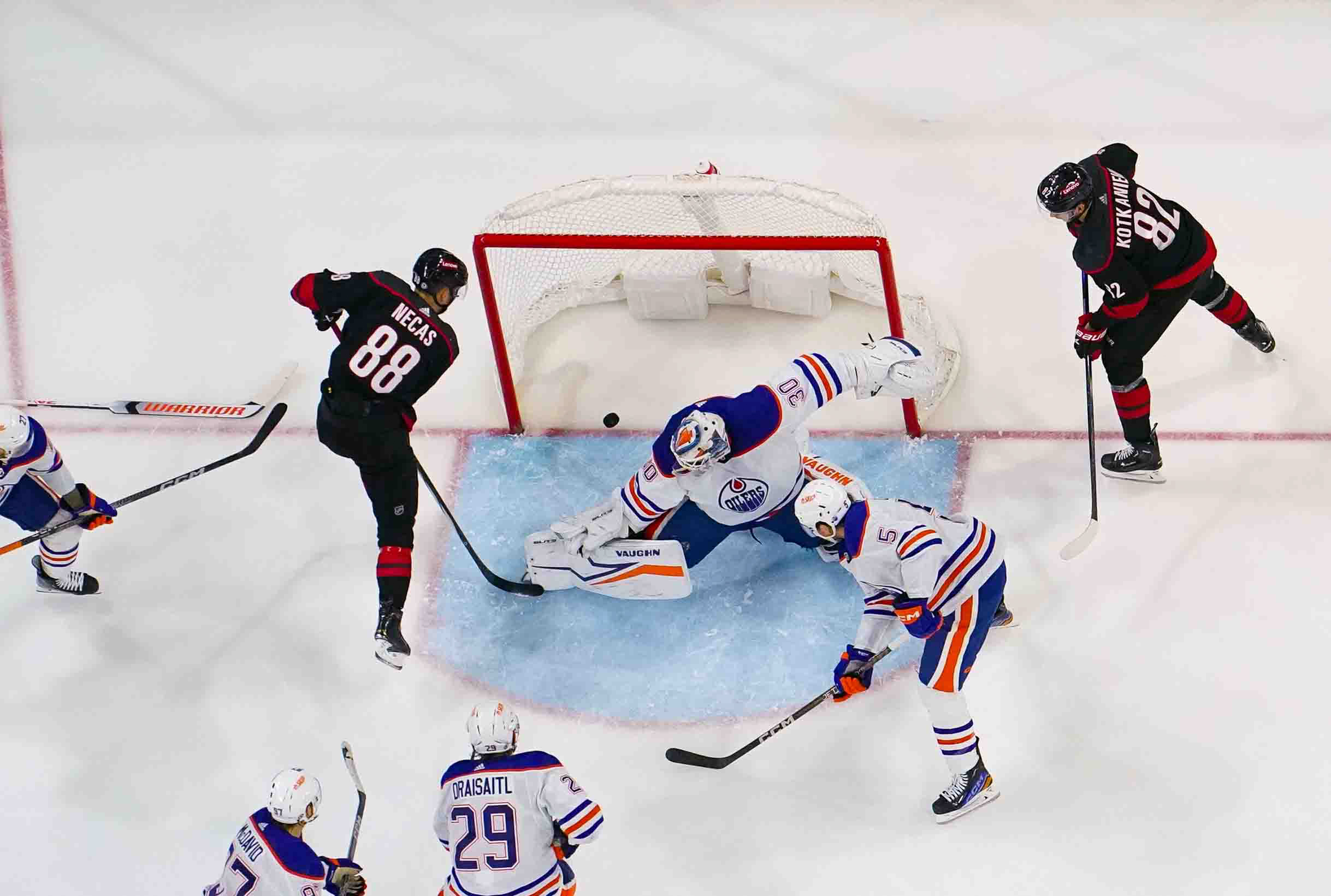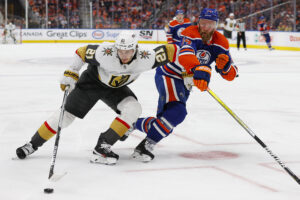This season for the Carolina Hurricanes has been rather difficult to assess. There has been little consistency with moments marked by high scoring with no defence, some with poor goaltending, and others with a lack of scoring with tight play. We took a look at many of the issues that shined during the team’s latest Western Canada road trip here. We then took a deeper look at some options for goaltending here, and options for goal scoring here. To wrap up our deeper dives into some of those issues, today we take a look at the team’s power play, and why it is specifically so important for the Hurricanes.
Carolina Hurricanes Power Play Rising but Not Quite There
The Hurricanes search for power play consistency and goal scoring have been consistent themes for a few seasons now. In the offseason, the team brought in Michael Bunting to help some in that department. The year before, they brought in Max Pacioretty, but injuries kept him out essentially all season. Also,this offseason the team brought back offensive defenceman Tony DeAngelo, as they were seeking power play help. These moves mixed with better play from Teuvo Teravainen, Jack Drury, Seth Jarvis and Stefan Noesen have helped the power play improve some this season.
Last year, the team ended at 19.8% on the power play. So far this season, they are at 21.7%, and good enough for top-15 in the league. Jarvis leads the team in power play goals, while Sebastian Aho, Teravainen and Bunting are tied for the lead in points. One negative this season, however, is the amount of shorthanded goals Carolina has allowed. This largely stems from sloppy play at the blue line leading to odd man rushes. But overall, the power play is better. But, it’s not quite where the team would like it to be.
A Slight Shift in Strategy
One thing that Carolina has done to increase its power play effectiveness is adjusted where it looks for chances. As shown by the charts below from hockyviz.com, last season Carolina’s power play heavily relied on shooting from the point. But as the chart on the right shows, the team has slightly adjusted, and is getting most of their chances from the left circle, the top of the circles, and the right doorstep of the net. The team is doing better at moving the puck quicker and looking for one timers across the ice. Last season they seemed to favour firing shots from the point with little movement. The right doorstop spot comes from tips and one timers fed from the left circle.
Carolina Hurricanes Power Play Coming in Waves
What has been interesting is that the power play effectiveness seems to comes in waves. Against the Washington Capitals on December 17, Carolina went 0-5 on the power play. They did score one, but it was called back for goaltender interference. That could have been the difference in the game. But against the Ottawa Senators on December 12, they went a perfect 2-2. When the team went down a goal, it was the power play that got them back into the game. Then against the Nashville Predators on December 15, they went 2-3 en route to scoring five goals. But the whole trip through Western Canada saw them come up dry.
The point is that when they click and score, they tend to be on for the game. But when it’s not working, it seems like nothing will go. Overall, its better. But consistency would go a long way.
System Requiring Error Free Hockey with High Shot Volume
So the power play is important for any team, but why is it especially important for this team? This requires looking at the system as a whole and how it produces. To over-simplify, at 5v5, it favours quantity over quality in shot generation. It also favours shot suppression defensively. It’s a game of odds that plays the statistics to say if we can control the shooting and chance generation, more times than not we will win. That has generally worked over the regular season, where the sample size is large. But, it has come back to bite them in the playoffs, where there is less time to average out the odds.
So the system is what it is, and it works if everyone is on board. But one weak point of the system in its operation is what happens when there is a breakdown or two that end up in the back of the net, and the Hurricanes offence has only thrown 40 shots at the goalie’s chest. Teams that are strong defensively with a good transition game can hunker down, weather the “storm,” and then counterattack with a grade A chance to find the back of the net. If Carolina is only getting low danger shots, the other team’s risk of letting in a goal is low. This means that Carolina’s system has to be fairly mistake free with little let up in pressure. It can be done, but it’s tough.
So if the 5v5 game focuses on chance generation offensively and chance suppression defensively, where does the power play sit?
The Power Play Giving Quality Chances over Quantity
An effective power play under Rod Brind’Amour‘s system can actually act as a counter to the 5v5 system mentioned above. The team will still want to work hard, win pucks on the forecheck, and generate chances. With a man-advantage, the focus shifts from the amount of shots to the quality. This is seen in the increase in power play effectiveness from last year to this as shown above. As much as the crowds want the power play to “shoot,” and teams can over-pass at times, the key to the power play is puck movement for quality chances. A penalty kill in a box, a diamond or any other formation doesn’t have to do much if the power play is just standing and shooting.
This becomes the time for the offensive players to shine and use their creativity. If the team can net one, or a few, on the power play, the 5v5 play is set up to play a tight game. The power play becomes that “opportunity” to swing the game in their favour. This isn’t relying on the power play to win, but it’s where the team can play an opportunistic game mixed into a more odds-driven game. Get a goal or two, then grind out the team the rest of the game.
The Power Play Can Mask the Lack of a Pure Sniper
The Hurricanes are also without a true sniper, and have been for some time. Sure, there are some players who can find the back of the net, like Aho, Andrei Svechnikov, and at times, Martin Necas. But none are really in that pure goal-scorer mold. The team would likely benefit from searching for someone to bring in to fit that role, but a good power play can help mask this deficiency.
At least in theory, on the man-advantage, the team should be looking for goals that result from odd-man matchups. Yes, everyone knows that players like Alex Ovechkin and Steven Stamkos are lethal on the power play due to their one-timing ability, but an effective power play doesn’t have to have the game’s best shooters. If the strategy is executed effectively, the team can move the penalty kill to the point it cracks and find someone in an open spot for a relatively easy goal. Sure, guys whiff and mess up, but you don’t have to be a 50-goal scorer to net a few open net backdoor passes.
The other way a power play can be effective offensively is actually outworking the penalty kill. Every loose puck has two men on it fast, and every puck around the net is getting whacked at for rebounds. We are still talking quality over quantity here, but Carolina lives and dies on hard work. This can work on the power play too. You don’t take 100 aimless shots hoping for a lucky bounce, but when you make a play and get a shot, you crash the net or win the puck back through hard work to set it up again.
System Evolving and Power Play Importance
While a top-rated power play will not guarantee regular season or playoff success, statistics tend to show that most Stanley Cup winners have fairly good power plays. The reason in the playoffs is the aspect mentioned above of quality versus quantity in a shorter time frame for results. If Carolina’s power play can keep improving, their 5v5 quantity-based hockey can work. The power play will be the offensive injection into an otherwise very defensively-focused hockey team. The saying goes “defence wins championships.” Carolina typically has that. But they have to score to win. The man-advantage is a crucial opportunity to do so.
Main Photo Credit: James Guillory-USA TODAY Sports






